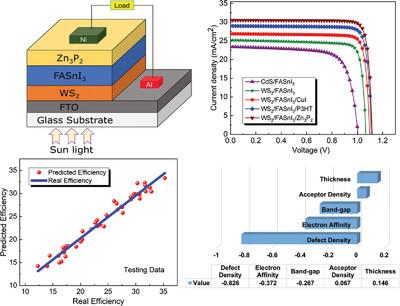当前位置:
X-MOL 学术
›
Adv. Theory Simul.
›
论文详情
Our official English website, www.x-mol.net, welcomes your
feedback! (Note: you will need to create a separate account there.)
Investigating the Performance of FASnI3‐Based Perovskite Solar Cells with Various Electron and Hole Transport Layers: Machine Learning Approach and SCAPS‐1D Analysis
Advanced Theory and Simulations ( IF 2.9 ) Pub Date : 2024-07-06 , DOI: 10.1002/adts.202400353 Tanvir Mahtab Khan 1 , Sheikh Rashel Al Ahmed 1
Advanced Theory and Simulations ( IF 2.9 ) Pub Date : 2024-07-06 , DOI: 10.1002/adts.202400353 Tanvir Mahtab Khan 1 , Sheikh Rashel Al Ahmed 1
Affiliation

|
In this study, tungsten disulfide (WS2 ) as an electron transport layer (ETL) and zinc phosphide (Zn3 P2 ) as a hole transport layer (HTL) are incorporated to improve the performance of the FASnI3 ‐based perovskite solar cell (PSC). The solar cell capacitance simulator in one dimension (SCAPS‐1D) is used to investigate the photovoltaic (PV) performances of the heterojunction Al/FTO/WS2 /FASnI3 /Zn3 P2 /Ni solar structure. The performance metrics of proposed device with numerous ETLs and HTLs are discussed. The suggested device provides appropriate band structures, which in turn potentially reduce minority electron recombination, thereby enhancing overall performances. Influences of various physical parameters such as thickness, doping concentration, bulk defect, interface defect states, work function, and back surface recombination velocity (BSRV) on the device performances have also been analyzed. An efficiency of 29.81% is achieved at the optimum thicknesses of 0.05 µm for WS2 ETL, 1.0 µm for FASnI3 absorber, and 0.1 µm for Zn3 P2 HTL. Furthermore, a machine learning algorithm is used to assess the impact of multiple semiconductor parameters, and found that defect density influences the most. This model, which has an approximate correlation coefficient (R 2 ) of 0.937, can predict the data with precision. Therefore, these numerical outcomes will help researchers further design and manufacture a low‐cost and highly efficient FASnI3 ‐based PSC.
中文翻译:

研究具有各种电子和空穴传输层的基于 FASnI3 的钙钛矿太阳能电池的性能:机器学习方法和 SCAPS-1D 分析
在这项研究中,采用二硫化钨(WS2)作为电子传输层(ETL)和磷化锌(Zn3P2)作为空穴传输层(HTL)来提高基于FASnI3的钙钛矿太阳能电池(PSC)的性能。一维太阳能电池电容模拟器 (SCAPS-1D) 用于研究异质结 Al/FTO/WS2/FASnI3/Zn3P2/Ni 太阳能结构的光伏 (PV) 性能。讨论了所提出的具有大量 ETL 和 HTL 的设备的性能指标。建议的器件提供了适当的能带结构,这反过来又可能减少少数电子复合,从而提高整体性能。还分析了厚度、掺杂浓度、体缺陷、界面缺陷态、功函数和背表面复合速度(BSRV)等各种物理参数对器件性能的影响。 WS2 ETL 的最佳厚度为 0.05 µm,FASnI3 吸收剂的最佳厚度为 1.0 µm,Zn3P2 HTL 的最佳厚度为 0.1 µm,效率达到 29.81%。此外,使用机器学习算法评估多个半导体参数的影响,发现缺陷密度影响最大。该模型的相关系数(R2)近似为0.937,可以准确地预测数据。因此,这些数值结果将帮助研究人员进一步设计和制造低成本、高效的基于 FASnI3 的 PSC。
更新日期:2024-07-06
中文翻译:

研究具有各种电子和空穴传输层的基于 FASnI3 的钙钛矿太阳能电池的性能:机器学习方法和 SCAPS-1D 分析
在这项研究中,采用二硫化钨(WS2)作为电子传输层(ETL)和磷化锌(Zn3P2)作为空穴传输层(HTL)来提高基于FASnI3的钙钛矿太阳能电池(PSC)的性能。一维太阳能电池电容模拟器 (SCAPS-1D) 用于研究异质结 Al/FTO/WS2/FASnI3/Zn3P2/Ni 太阳能结构的光伏 (PV) 性能。讨论了所提出的具有大量 ETL 和 HTL 的设备的性能指标。建议的器件提供了适当的能带结构,这反过来又可能减少少数电子复合,从而提高整体性能。还分析了厚度、掺杂浓度、体缺陷、界面缺陷态、功函数和背表面复合速度(BSRV)等各种物理参数对器件性能的影响。 WS2 ETL 的最佳厚度为 0.05 µm,FASnI3 吸收剂的最佳厚度为 1.0 µm,Zn3P2 HTL 的最佳厚度为 0.1 µm,效率达到 29.81%。此外,使用机器学习算法评估多个半导体参数的影响,发现缺陷密度影响最大。该模型的相关系数(R2)近似为0.937,可以准确地预测数据。因此,这些数值结果将帮助研究人员进一步设计和制造低成本、高效的基于 FASnI3 的 PSC。











































 京公网安备 11010802027423号
京公网安备 11010802027423号